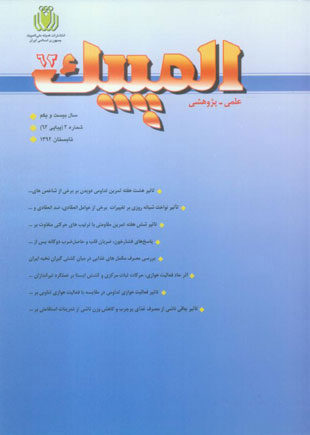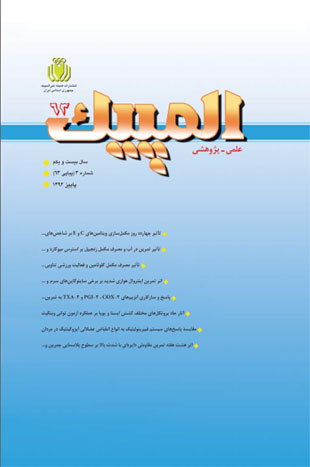فهرست مطالب

فصلنامه المپیک
سال بیست و یکم شماره 2 (پیاپی 62، تابستان 1392)
- 132 صفحه،
- تاریخ انتشار: 1392/07/15
- تعداد عناوین: 8
-
Page 7The purpose of this study was to assess effect of eight weeks running continuous training on response of selected kidney functional markers to acute exercise session. Twenty sedentary healthy males were selected (mean±SD; age: 23/95±2/50 yrs, weight: 73/85±6/46 kg, height: 174±4/75 cm) and randomly divided into equal two groups: experimental and control. In beginning, before and after one acute exercise session (walking 200 meters, running 600 meters with %60 of HRR, running 1500 meters with %85 of HRR, running 600 meters with %60 of HRR and walking 200 meters) urine samples were taken for evaluating hematuria, proteinuria, urinary creatinine exertion and protein to creatinine ratio. Then the experimental group trained continuous running for eight weeks, 3 times per week. But during this time control group did not participate in any exercise. Finally, all subjects participated in second acute exercise session and urine samples were similarly taken again. Data were analysed using repeated measure ANOVA, Friedman test and independent t test. Significance was indicated by p values < 0.05. Results of this study showed that hematuria, proteinuria and protein to creatinine ratio increased after acute session. In addition Results of this study showed that following acute session, hematuria, proteinuria, creatinine excretion rate and protein to creatinine ratio were significantly decreased after eight weeks continuous running training (p< 0/05). Also there was significant difference in hematuria, proteinuria and protein to creatinine ratio between two groups (p< 0/05). It can be concluded that eight weeks of endurance running training in sedentary healthy males cause of adaptation and reduction in level of hematuria, proteinuria, protein to creatinine ratio and urinary creatinine excretion following acute exercise.Keywords: Hematuria, Proteinuria, Creatinine, Protein to Creatinine Ratio, Acute Exercise, Continuous Running Training
-
Page 21The purposes of present study was comparing maximal oxygen consumption (vo2 max), some of coagulant factors including fibrinogen, platelet، P-LCR، PDW, MPV, and anti coagulant factors including protein C as a result of one bout of incremental exercise during morning and afternoon. Subjects of this study included 15 sport man with at least 2 years experience of participation in sport activities (age: 19±1. 2 years, height: 172. 1±5. 2 cm, weight: 66. 8±7. 5 kg). Subjects were selected randomly from volunteer and eligible students. Measurements were performed during morning (8 am) and afternoon (6 pm). Exercise training included maximal incremental exercise test of Bruce. During morning and evening (2 days interval) blood samples were taken before exercise test, after half an hour resting, Bruce maximal exercise test on treadmill was performed and immediately after test the second blood samples were taken. Heart rate and VO2max were recorded at the end of exercise test. Results of this study indicated significant increasing of MPV, Protein C, and P-LCR in morning compared to afternoon and Platelet in afternoon compared to morning after exercise (P≤0. 05). VO2max, heart rate and fibrinogen indicated no significant difference in morning compared to afternoon (P>0. 05). In summary we can suggest that although exercise performance was not significantly different in morning and afternoon, regarding increasing some of anticoagulant in afternoon and coagulant factor in morning as a result of exercise, afternoon exercise is preferred than morning exerciseKeywords: Circadian Rhythm, Protein C, Fibrinogen, Platelet, VO2max
-
Page 31One of the methods that are used to manipulate resistance training, changes in the sequence of activities. The present study was performed to investigation the effects of resistance training with different exercise order on serum IL-6 and CRP in overweight women (BMI= 25- 30 Kg/m2). 31 overweight students were purposefully selected and then randomized into three groups: The experimental group 1 (n= 10), the experimental group 2 (n= 11) and the control group (n= 10). Resistance training consists of 6 weeks (3 sessions per week). IL-6 and CRP before treatment and again after completion of the training period were measured. Findings using one-way ANOVA revealed no significant differences in the IL- 6 levels between the three groups, but the CRP in the experimental group 2, was seen a significant reduction compared to the experimental group1(p= 0.006) and the control group(p= 0.016). In general, the present findings indicated that small or large muscles group involved in the beginning of the exercise sessions has no effect on the IL-6 response, although, CRP was reduced for small to large exercise order.Keywords: Exercise order, Inflammatory Factors, Over, Weight
-
Page 45The aim of this study was to investigate the systolic (SBP) and diastolic blood pressure (DBP), heart rate (HR) and double product (DP) responses during recovery from different body segments resistance exercises. Twelve untrained normotensive men (age, 23.7±1.4yrs; height, 176.4±4 cm; weight, 68.1±8.5 kg) randomly participated in three sessions of upper limbs (UL), lower limbs (LL) and whole body (WB) resistance exercise as well as a control session without exercise (CON). In the exercise sessions, subjects performed 4 exercises with 65% of 1RM, 3 sets of 10 repetitions with 2 min rest interval between sets and exercises. SBP, DBP, HR, DP were measured before exercise and at intervals of 15 min for 60 min after exercise. The Analysis of Variance (ANOVA) with Repeated Measures (group × time) was used to analyze of data, followed by post-hoc Bonferroni test for p≤0.05. SBP decreased significantly for 60 min after resistance exercise trials, while there was no significant difference in DBP. HR significantly increased and remained at high level until 60 min after UL and LL and 45 min after WB. Significant increase in DP observed 15 min after LL and 30 min after UL and WB. Also, observed no differences for SBP, DBP, HR and DP between the trials. It can be concluded that UL, LL and WB resistance exercise lead to occurrence of post-exercise hypotension (PEH) with same magnitude and duration.Keywords: Resistance Exercise, Blood Pressure, Heart Rate, Double Product
-
Page 59The purpose of this research was to survey dietary supplements consumption among Iranian elite wrestlers. For gathering of information regarding type, patterns of consumption, resource of recommendation, resource of information about supplements, motivation of supplements consumption, ways of purchase, factors influencing on consumption and type of information about supplements, a 8 page questionnaire were distributed among wrestlers, whose participated in national team campings. Data were calculated as frequencies and percentages. Results indicated that 42% of wrestlers regularly used supplement. The most commonly supplements were protein, vitamin supplements. 71% of wrestlers were ingested when training or in-season. Athletes and coaches were the most often mentioned source of supplement recommendation. The main reason for dietary supplementation was performance enhancing properties. Recommendation of athletes was the major factor influencing the selection of supplement. Pharmacy was the common place of supplement purchase.Keywords: Nutrition, Dietary Supplement, Elite Wrestlers of Iran, Prevalence
-
Page 75The purpose of this research was study of acute effects of aerobic exercise, core stability exercise and static stretch on elite women shooters performance. For this Sixteen female shooters participated in the study randomly assigned to four groups of Aerobic: five minutes of aerobic activity, Core stability: five-minute Core stability movements on the floor, stretch: five-minute total body static stretching and Control. All subjects carried out four protocols in two consecutive days as the cross design. After each Protocol, participants performed 20 shots with air pistol. Shooting performance analyzed by Scatt Shooting Training System. The data analyzed by the ANOVA with repeated measures method. Aerobic group's Record, significantly higher than other groups. Shot group was higher between aerobic with core stability and stretch groups, significantly. It was shown significant difference between aerobic group with stretching and control groups, in the stability on center of target. However, the difference in fluctuations of the aiming point was not significant between four groups. The results suggested that moderate intensity aerobic in a way that engages the neuromuscular coordination can improve shooting performance.Keywords: Shooting, Static Stretch, Core Stability, Aerobic
-
Page 89The aim of this research was to determine the effect of continuous aerobic activity in comparison with interval aerobic activity on serum serotonin and to rate the perceived exertion (RPF) according to Borg scale. Ten athletic girl(22.9±2.3 years, weight 53.8±2.5 kg, body mass index 20.6±1.0 kg⁄m2, fat percent 20.8±3.7and VO2max 41.7±1.8 ml.kg-1.min-1) selected to attend in studying. Blood samples were given before and 10 minutes after the end of the test include of 10 minutes warming conducted interval or continuous aerobic activity on treadmill for 40 minutes. Statistical analysis of data by using variance analysis of repetitive measurement showed that there is significant difference between different stages of serum Serotonin sampling (P=0/05). LSD post hoc test for couples comparison showed that interval aerobic activity caused significant increase in serum serotonin (P=0/028) but there wasn’t significant difference in serum serotonin amount before or after continuous aerobic activity test (P>0/05). Using of one way ANOVA showed that, in variation width of serum serotonin, there wasn’t significant difference between both aerobic activity types (P 0/05). On the other hand results of paired sample t test showed that rate of perceived pressure in interval aerobic activity was significantly more than continuous aerobic activity (P=0/01). Thus it seems that central fatigue level in interval aerobic activity is more than continuous aerobic activity because the amount of serum serotonin increase in interval activity is more than that of continuous activity, and rate of perceived pressure is more in interval activity.Keywords: Serotonin, Rating of Perceived Exertion, Continuous Aerobic Activity, Interval Aerobic Activity
-
Page 99The aim of this study was evaluating the effect of highfat iet-induced obesity and weight reduction due to endurance training with two different intensities on plasma leptin in C57BL/6 mice. Thirty C57BL/6 mice (3-4 weeks; 10-15 g) were recruited in this study. Twenty four mice consumed a high-fat diet (60% fat) and 6 mice nourished a standard diet (35% fat) for 12 weeks. 6 obese mice (group: OB) and 6 nonobese mice (group: NB) were killed for basal measurements. After obesity period, 12 mice were trained 5 sessions per week for 12 weeks on a rodent treadmill with high (group: HI) and/or low intensity (group: LI). Each session, the LI group ran at a speed of 15 m/min and 5% incline (~50% VO2max) for 60 min and the HI group at a speed of 22 m/min and 5% incline (~75% VO2max) for 41 min. 6 other obese mice (group: OC) were kept in the cages as the control group till the end of training.Body weight was measured and recorded weekly. Plasma leptin was measured using a specific kit by ELISA method. From 5th week on, mean weight in the groups which had a high-fat diet (OB, OC, HI & LI) showed a significant increase compared to the NB group (p<0.05). In training groups, weight reduction started from 6th week compared to the OC group and at 8th week it was significant (p<0.05). The rate of weight reduction was significantly higher in the HI group than the LI group in 11th and 12th weeks (p<0.05). Plasma leptin concentrations increased 24% in OB compared to the NB group (p<0.05). Plasma leptin concentrations in OC were slightly lower than the NB group, but it declines 27% compared to the OB group (p<0.05). Relative leptin value per gram body weight in OC, HI and LI groups was similar and lower than the two other groups. Blood leptin concentration, although, is closely related to obesity indexes such as BMI, body fat percentage and body fat mass in human and animals, and apparently weight reduction can lead to leptin concentration decrease; however, these results suggest that high-fat diet independent to weight reduction, also, plays a role in hyperleptinemia.Keywords: Obesity, High, Fat Diet, Leptin, Endurance Training


